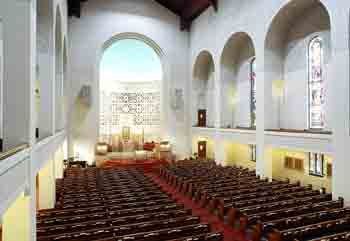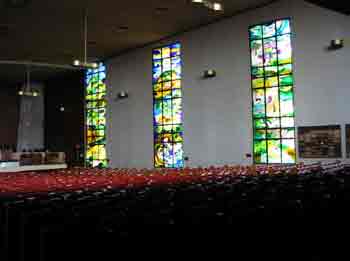Toronto, Canada
by Joanna Sloame
Toronto is the largest city in Canada and the provincial capital of Ontario, with a population of approximately 2.5 million people. Toronto is also one of the largest Jewish Diaspora centers; in 2001, there were approximately 114,000 Jews in the city of Toronto and another 65,000 in the surrounding GTA municipalities. That population continues to grow annually.
Early History
The land now known as Toronto was claimed by France after being discovered by the French explorer Etienne Brule, a member
of the Samuel Champlain expedition in 1608. It became part of the French
colony of Quebec in 1615, and remained so until 1760, when the British
gained control of the region during the French and Indian War. In 1791,
the British divided Quebec into two provinces. Upper Canada, now Ontario,
stretched west from the Ottawa River, and Lower Canada, now Quebec,
encompassed all the land to the east of the Ottawa.
 Holy
Blossom's sanctuary
Holy
Blossom's sanctuary |
It
was not until the 1840s that small numbers of Jewish immigrants from
Western and Central Europe began to arrive in Ontario and settle in
the cities of Hamilton, Kingston, and Toronto. In 1849, Abraham Nordheimer
moved from Kingston to Toronto and purchased a plot of land for a cemetery
on behalf of the Toronto Hebrew Congregation. The congregation was originally
an Orthodox synagogue,
made up of members from Germany,
including Bavaria, Bohemia, and Alsace, Great
Britain, the United States, Russia, Galicia, and Lithuania.
It became known as the Daytshishe Shul because of its modernized services.
In 1856, Lewis Samuel of York, England, immigrated
to Toronto and helped organize the Sons of Israel Congregation. In 1858,
the two congregations combined to form the Toronto Hebrew Congregation-Holy
Blossom Temple. Holy Blossom was Orthodox, but in the 1920s joined the
Union of American Hebrew Congregations and became Reform.
It was the only Reform temple in Toronto until the 1950s, when it was
joined by Temple Sinai and Temple Emanu-El. Today Holy Blossom is the
largest Reform Congregation in Canada.
 Main
Sanctuary of Adath Israel Congregation,
located in the North York Section of
Toronto.
Main
Sanctuary of Adath Israel Congregation,
located in the North York Section of
Toronto. |
In the 1880s, the arrival of large numbers of Eastern European Jews escaping
the pogroms of czarist Russia, led to the creation of three new synagogues.
Goel Tzedec and Beth Hamidrash Hagadol Chevra T'Hillim were founded in
1883, and were made up of mostly Russian members. They merged in the early
1950s to form Beth Tzedec, a Conservative congregation. The third synagogue, Shomrei Shabbos, was started in 1889
by Orthodox Galician Jews. Also in 1889, Beth Jacob, known as the Poylishe
Shul and Rumanian Synagogue or Adath Israel came into existence.
By the 1940s, Toronto had about 60 synagogues. These were mainly small
Landsmannschaften, which were immigrant synagogues that represented
the different hometowns of settlers from Russian Poland,
the Ukraine, Lithuania,
and Belorussia. In the 1950s and 60s, the smaller shtiblekh merged into
larger synagogues. Therefore, the number of synagogues decreased, but
in their place were larger and more stable congregations.
The Jewish population of Toronto started out small in the 18th and
19th centuries and grew slowly but steadily into the early 20th century.
In 1871, 157 Jews lived in Toronto, in 1891, the number rose to 1,425,
and, by 1901, the Jewish population had increased to 3, 090. The size
of the community always depended on waves of immigration from Europe,
based on pogroms and persecution in various countries. In 1911, the
Jewish population of Toronto had expanded to 18,237 and, by 1921, had
almost doubled to 34,619. In 1931, 45,000 Jewish immigrants, made up
of mostly Poles, settled in Canada after the United States tightened
its immigration quota in 1924. Immigration preceding and during World
War II declined significantly because of restrictions imposed by
the Canadian government during the Depression. This was a huge blow
to Eastern European Jews trying to escape persecution, and only small
groups of Austrian and German Jews fleeing Hitler were able to immigrate to Toronto during this period. In 1941, the number
of Jews in Toronto had only risen slightly to 49,046, despite the thousands
who desperately sought refuge in Canada.
Postwar Toronto
After World War II, the Canadian government established anti-discrimination
laws and eased immigration regulations. The Canadian Jewish Congress
and needle traders helped refugees come to Toronto from displaced
persons camps. In addition, an important development in the Toronto
community was the growth of the Jewish day school system in the post-World
War II era. Previously, the Montreal and Winnipeg Jewish communities
had larger networks of congregational and day schools.
The 1950s and 60s saw a tremendous growth of population and community
life. In 1951, the Jewish population of greater Toronto reached 66,773.
It was augmented further after the 1956 Hungarian uprising brought a
new influx of Jewish refugees to the city. In the 1960s, the first Sephardic Jews came to Toronto from Morocco,
and established the first Sephardic synagogues and organizations in
the city.
Toronto's economic developments of the 1960s, combined with the rise
of Quebec's separatist movement in the 1970s, led to a mass migration
from Montreal to Toronto in the late 70s and early 80s. In 1971, the
Jewish population stood at 105,000, by 1981, it reached 128,650 and,
by 1991, increased to 162,605. When the Parti Quebecois won the provincial
election in 1976, 20,000 to 30,000 Jews fled to Toronto, fearing an
independent Quebec would divide and weaken the national Jewish community.
Toronto assumed Montreal's position as the center of Jewish activity.
However, the economic recession of the 1990s had a deleterious impact
on the Jewish community's finances and its ability to subsidize Jewish
day schools. Despite this setback, Toronto maintains the largest Jewish
population of any Canadian city.
In recent years, Toronto has received Jewish immigrants from South
Africa, the former Soviet
Union, the United States,
and Israel. Today, the
Jewish community stands at approximately 150,000 out of Toronto's 3.5
million inhabitants. Most Jews living in Toronto have only been there
for one or two generations. With such close ties to their homelands,
Torontonian Jews are typically more traditional than those in the rest
of Canada and the United States. Of the 50 percent or so of the Jewish
population that associate themselves with the community, 20 percent
are Orthodox, 40 percent Conservative, 35 percent Reform, and the remainder nondenominational.
In addition, a Reconstructionist synagogue opened in Toronto in February 2008, Congregation Darchei Noam. Toronto maintains around 50 synagogues, a growing network of Jewish
day schools, and a number of Jewish organizations.
Tourist Sites & Contacts
Oldest
Congregation in Toronto
Holy Blossom Temple
1950 Bathurst Street
Tel. (416) 789-3291
http://www.holyblossom.org/
Historic Jewish Cemetery
Holy Blossom Cemetery
Jones Avenue
Holocaust Education & Memorial Centre
Lipa Green Building
4600 Bathurst Street
Tel. (416) 635-2883
Canadian Jewish Congress
http://www.cjc.ca/
Sources:
History
of Toronto and County of York
Israelowitz, Oscar. Canada
Jewish Travel Guide. Israelowitz Publishing.
Brooklyn, NY: 1992.
Tigay, Alan M. (ed.) The
Jewish Traveler. Hadassah Magazine. Northvale,
New Jersey: 1994.
"Canada", "Ontario", "Toronto",
"Landsmannschaften" Encyclopedia
Judaica
Photo Credits: JBuff.com |